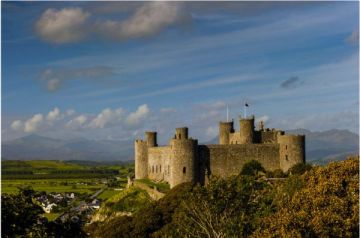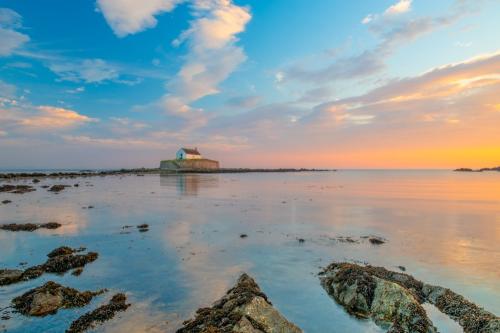
St Cwyfan’s Church (known in Welsh as Eglwys Cwyfan) is a 12th-century church on a tidal island named Cribinau, near Aberffraw, on the western coast of Anglesey. The church can only be accessed at low tide by means of a rocky causeway; at other times it is cut off from the mainland, giving it its popular nickname, 'The Church in the Sea' (sometimes The Little Church in the Sea or Eglwys fach y mor).
The church is dedicated to St Cwyfan, known in English as St Kevin. Cwyfan died in AD 618 and is best known for founding an abbey at Glendalough, in County Wicklow, Ireland.
When it was built, St Cwyfan’s Church stood on a headland at the meeting of two bays. To the north lies Porth China, and to the south is Porth Cwyfan.
Over the centuries, the headland suffered from constant erosion, with the result that the bays became linked and the church became cut off from the mainland except at low tide.
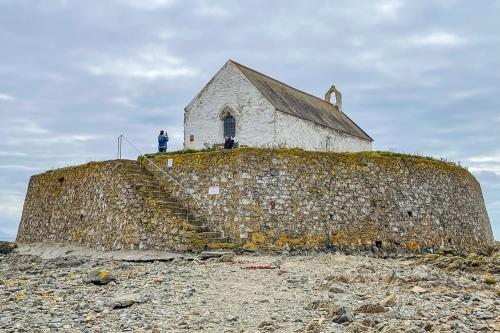
History
A church was established here as early as the 7th century, but the earliest part of the building we see today is a section of the south wall, erected in the 12th century. The remaining walls date to a 14th-century rebuilding. A north aisle was added in the 16th century, but this was removed in the early 1800s, leaving three blocked arches in the north wall as a reminder.
The aisle's removal was made necessary because erosion gradually wore away the cliffs on that side of the church, leaving the church at risk of falling into the sea. The church was abandoned and a new church was erected at Llangwyfan, on the mainland.
By the latter part of the 19th century, erosion had become so pronounced that graves began falling into the sea. That was when a local architect named Harold Hughes stepped in. Hughes raised awareness of the decaying church and was able to gather enough in donations to pay for a seawall and for essential repairs to the decaying building.
The result is the Church in the Sea that we see today, defended by a high stone seawall and reached only by a causeway.
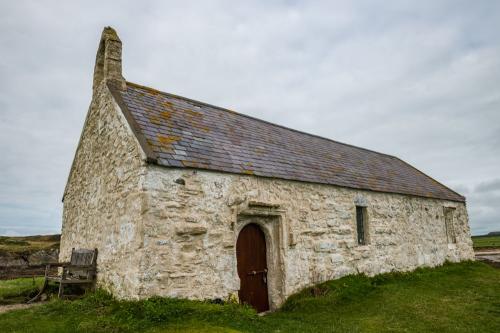
A Religious Scandal
In 1766 the Bishop of Bangor appointed a new priest for the parish of Trefdraeth, a parish that included St Cwyfan’s Church. The only problem was that the new priest, named Thomas Bowles, spoke no Welsh, whilst his congregation was almost entirely Welsh-speaking.
Only five of his new parishioners could understand Bowles, so the congregation appealed to the bishop to remove Bowles and replace him with a Welsh-speaking priest.
The case was heard in an ecclesiastical court in 1773, and the judge ruled that there was no legal basis to remove Bowles from his position, but that, in future, only Welsh-speaking priests should be appointed to serve parishes with a Welsh-speaking majority. You could say that the parishioners lost the battle but won the war.
In any case, Bowles died a few months after the verdict and was replaced by a Welsh-speaking priest.
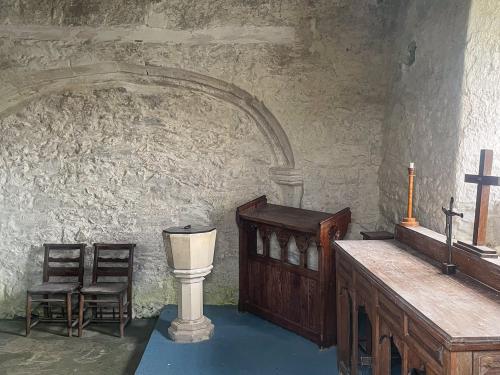
Getting There
There are two routes to the Church in the Sea and both involve a short walk along a shingle beach and the causeway that leads to Cribinau.
The first route is from the north, where a lane leads off the A4080 towards the Anglesey Circuit, a motor racing track. You have to park before you reach the track and walk down the paved road, past the circuit, to Ty-Cwyfan, where you can join the Isle of Anglesey Coastal Path. You will see the church directly ahead of you.
The second, and more popular route, is to turn off the A4080 at Aberffraw and follow the signs for Eglwys Cwyfan. The road becomes a country lane and winds through open countryside until it reaches a lay-by on the cliffs above Porth Cwyfan. You will see the Church in the Sea a few hundred yards ahead, to the north.

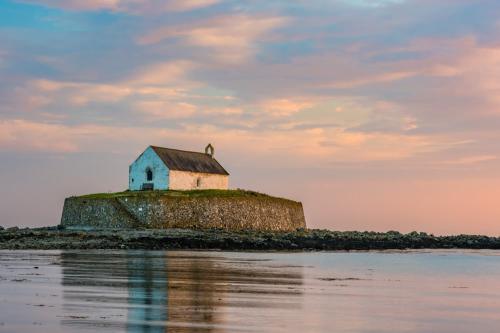
The walk from the lay-by to the church is slow due to the mix of shingle and sand on the beach, but it is reasonably level and easy and should take no more than ten minutes (or less if the tide is out).
We have visited the Church in the Sea several times; once to photograph it at sunset, when the tide was high and the church seemed to float on the water, and once at low tide when we could walk across the causeway to the church.
The Church in the Sea is a popular venue for weddings, despite the challenges of getting there. Unfortunately, it is generally closed when not in use for services, and you will have to be content with peering in the windows to get a sense of the interior.
About Church in the Sea, Anglesey
Address: Porth Cwyfan,
Aberffraw,
Anglesey,
Anglesey,
Wales, LL63 5PJ
Attraction Type: Historic Church
Location: At the end of the lane from Aberffraw to Porth Cwyfan, off Church Street. Park at the end of the road and follow the Isle of Anglesey Coastal Path north for about ten minutes. The church will be in view the entire time. Be aware of the tide if you want to walk out to the church!
Location
map
OS: SH336683
HERITAGE
 We've 'tagged' this attraction information to help you find related historic attractions and learn more about major time periods mentioned.
We've 'tagged' this attraction information to help you find related historic attractions and learn more about major time periods mentioned.
Find other attractions tagged with:
NEARBY HISTORIC ATTRACTIONS
Heritage Rated from 1- 5 (low to exceptional) on historic interest
Aberffraw Roman Fort - 1.3 miles (Roman Site) ![]()
Barclodiad y Gawres - 1.6 miles (Prehistoric Site) ![]()
Llangadwaladr, St Cadwaladr's Church - 3 miles (Historic Church) ![]()
Ty Newydd Burial Chamber - 3.5 miles (Prehistoric Site) ![]()
Din Dryfol Chambered Tomb - 4.4 miles (Prehistoric Site) ![]()
Llanddwyn Island - 4.7 miles (Historic Building) ![]()
Llys Rhosyr - 5.7 miles (Historic Building) ![]()
Bodowyr Burial Chamber - 7.8 miles (Prehistoric Site) ![]()
Nearest Holiday Cottages to Church in the Sea, Anglesey:
Aberffraw, Gwynedd
Sleeps: 5
Stay from: £618 - 1947
More self catering near Church in the Sea, Anglesey



